Numerical Simulations of the Monotonic and Cyclic Behaviour of Offshore Wind Turbine Monopile Foundations in Clayey Soils
Abstract
:1. Introduction
- 1.
- the possibility of using large areas allows for major projects, which may introduce super large turbines, with higher energy production;
- 2.
- the offshore wind speed is usually higher than under onshore conditions, which means that more energy can be generated in a given period (i.e., higher efficiency);
- 3.
- less wind turbulence is usually found for offshore conditions; therefore, the energy can be produced more efficiently and the risk of wind turbine structure fatigue can be also reduced.
- easy and fast installation: monopiles can be driven in by a hydraulic hammer and no prior soil reinforcement is required for the seabed [8];
- monopiles are easy to manufacture, which is critical for large wind farm projects that may require the production of hundreds of them [13];
- the jack-up rig that employed for oil and gas platform foundations can be compatible with monopiles; therefore, no special jack-ups are needed for monopile foundations [13];
- their analysis and design are relatively simple to undertake due to its regular geometry and aerodynamic behaviour under loads such as sea waves and wind. That makes these foundations easy to be modelled.
- establishing a finite element model for offshore wind turbine monopile foundations;
- validating the model with the corresponding centrifuge test under monotonic loads;
- validating the finite element model with a centrifuge test under cyclic loads;
- developing large diameter monopile models based on the previous validations;
- improving the understanding of the non-linear cyclic behaviour of monopiles in clays;
- developing a new monopile design procedure based on the numerical simulation results.
2. Methodology
2.1. Model Geometry and Boundary Conditions
2.2. Pile Modelling
2.3. Soil Modelling
2.4. Soil-Pile Interface
2.5. Input Loads
2.6. Mesh Density and Sensitivity Analysis
3. Validation of the Numerical Model
3.1. Centrifuge Tests
3.2. Input Parameters and Results of the Validations
4. Results
4.1. Time History of the Pile Rotation
4.2. Pile Rotation in the First Cycle
4.3. Cumulative Rate of Rotation
5. Procedure to Design Monopiles in Clay
- 1.
- determine the capacity of the offshore wind turbine; estimate the corresponding design horizontal load;
- 2.
- measure the undrained shear strength (Cu) of the clay in the seabed;
- 3.
- estimate the initial pile geometry that included the pile diameter (D) and the embedded depth (L);
- 4.
- calculate the pile wall thickness (through Equation (1));
- 5.
- 6.
- estimate the number of storm cycles that the offshore wind turbine may experience;
- 7.
- calculate the pile rotation under the number of storm cycles using Equation (7);
- 8.
- if the rotation was larger than the design requirement, then we need to modify the dimensions of the pile and repeat the procedure from step 3.
5.1. Design Example
5.1.1. 5MW Offshore Wind Turbine
5.1.2. 3.5 MW Offshore Wind Turbine
6. Conclusions
Author Contributions
Funding
Institutional Review Board Statement
Informed Consent Statement
Data Availability Statement
Conflicts of Interest
References
- HM Government. Meeting the Energy Challenge: A White Paper on Energy May 2007; Department of Trade and Industry: Norwich, UK, 2007; p. 7.
- European Commission. The Paris Protocol—A Blueprint for Tackling Change beyond 2020; European Union: Paris, France, 2015. [Google Scholar]
- European Union. The European Council in 2014; Publications Office of the European Union: Luxembourg, 2015. [Google Scholar]
- Ffrench, R.; Bonnett, D.; Sandon, J. Wind power: A major opportunity for the UK. Proc. Inst. Civ. Eng.—Civ. Eng. 2005, 158, 20–27. [Google Scholar] [CrossRef]
- Carter, J.M.F. North Hoyle offshore wind farm: Design and build. Proc. Inst. Civ. Eng.—Energy 2007, 160, 21–29. [Google Scholar] [CrossRef]
- Abdel-Rahman, K.; Achmus, M. Finite element modelling of horizontally loaded monopile foundations for offshore wind energy converters in Germany. In Proceedings of the International Symposium on Frontiers in Offshore Geotechnics (ISFOG), Perth, Australia, 19–21 September 2005. [Google Scholar]
- Moulas, D.; Shafiee, M.; Mehmanparast, A. Damage analysis of ship collisions with offshore wind turbine foundations. Ocean Eng. 2017, 143, 149–162. [Google Scholar] [CrossRef]
- DNV. Design of Offshore Wind Turbine Structures; Det Norske Veritas: Høvik, Norway, 2014. [Google Scholar]
- Doherty, P.; Gavin, K.; Casey, B. The geotechnical challenges facing the offshore wind sector. In Geo-Frontiers 2011: Advances in Geotechnical Engineering; Han, J., Alzamora, D.E., Eds.; American Society of Civil Engineers: Reston, VA, USA, 2011. [Google Scholar]
- Haiderali, A.; Nakashima, M.; Madabhushi, S. Cyclic lateral loading of monopiles for offshore wind turbines. In Frontiers in Offshore Geotechnics III, 1st ed.; Meyer, V., Ed.; CRC Press: Oslo, Norway, 2015; pp. 711–716. [Google Scholar]
- LeBlanc, C.; Houlsby, G.T.; Byrne, B.W. Response of stiff piles in sand to long term cyclic lateral loading. Geotechnique 2010, 60, 79–90. [Google Scholar] [CrossRef]
- API. Geotechnical and Foundation Design Considerations; American Petroleum Institute: Washington, DC, USA, 2011. [Google Scholar]
- LeBlanc, C. Design of Offshore Wind Turbine Support Structures: Selected Topics in the Field of Geotechnical Engineering. Ph.D. Thesis, Aalborg University, Aalborg, Denmark, 2009. [Google Scholar]
- Jung, S.; Kim, S.R.; Patil, A.; Hung, L.C. Effect of monopile foundation modeling on the structural response of a 5 MW offshore wind turbine tower. Ocean Eng. 2015, 109, 479–488. [Google Scholar] [CrossRef] [Green Version]
- Thomas, S. Geotechnical Investigation of UK Test Sites for the Foundations of Offshore Structures; The Stationery Office Books: London, UK, 1990. [Google Scholar]
- Lau, B.H. Cyclic Behaviour of Monopile Foundations for Offshore Wind Farms. Ph.D. Thesis, University of Cambridge, Cambridge, UK, 2015. [Google Scholar]
- ANSYS, Inc. Ansys® Workbench, Release 18.0 Academic; ANSYS, Inc.: Canonsburg, PA, USA, 2016. [Google Scholar]
- Lopez-Querol, S.; Cui, L.; Bhattacharya, S. Numerical methods for SSI analysis of offshore wind turbine foundations. In Wind Energy Engineering, 1st ed.; Letcher, T.M., Ed.; Academic Press: Cambridge, MA, USA, 2017; pp. 275–297. [Google Scholar]
- USACE. Engineering and Design-Settlement Analysis; U.S. Army Corps of Engineers: Washington, DC, USA, 1998.
- Haiderali, A.; Madabhushi, G. Three-dimensional finite element modelling of monopiles for offshore wind turbines. In Proceedings of the 2012 World Congress on Advances in Civil, Environmental, and Materials Research (ACEM 2012), Seoul, Korea, 26–29 August 2012; KAIST: Seoul, Korea, 2012. [Google Scholar]
- Lehane, B.M.; Chow, F.C.; McCabe, B.A.; Jardine, R.J. Relationships between shaft capacity of driven piles and CPT end resistance. Proc. Inst. Civ. Eng.—Geotech. Eng. 2000, 143, 93–101. [Google Scholar] [CrossRef]
- Ramsey, N.; Jardine, R.; Lehane, B.; Ridley, A. A review of soil steel interface testing with the ring shear apparatus. In Offshore Site Investigation and Foundation Behaviour; Society for Underwater Technology: London, UK, 1998. [Google Scholar]
- Byrne, B.W.; Houlsby, G.T. Foundations for offshore wind turbines. Philos. Trans. R. Soc. A 2003, 361, 2909–2930. [Google Scholar] [CrossRef] [PubMed]
- Zhang, C.; White, D.; Randolph, M. Centrifuge modeling of the cyclic lateral response of a rigid pile in soft clay. J. Geotech. Geoenviron. Eng. 2010, 137, 717–729. [Google Scholar] [CrossRef]
- Hong, Y.; He, B.; Wang, L.Z.; Wang, Z.; Ng, C.W.W.; Masin, D. Cyclic lateral response and failure mechanisms of semi rigid pile in soft clay: Centrifuge tests and numerical modelling. Can. Geotech. J. 2017, 54, 806–824. [Google Scholar] [CrossRef]
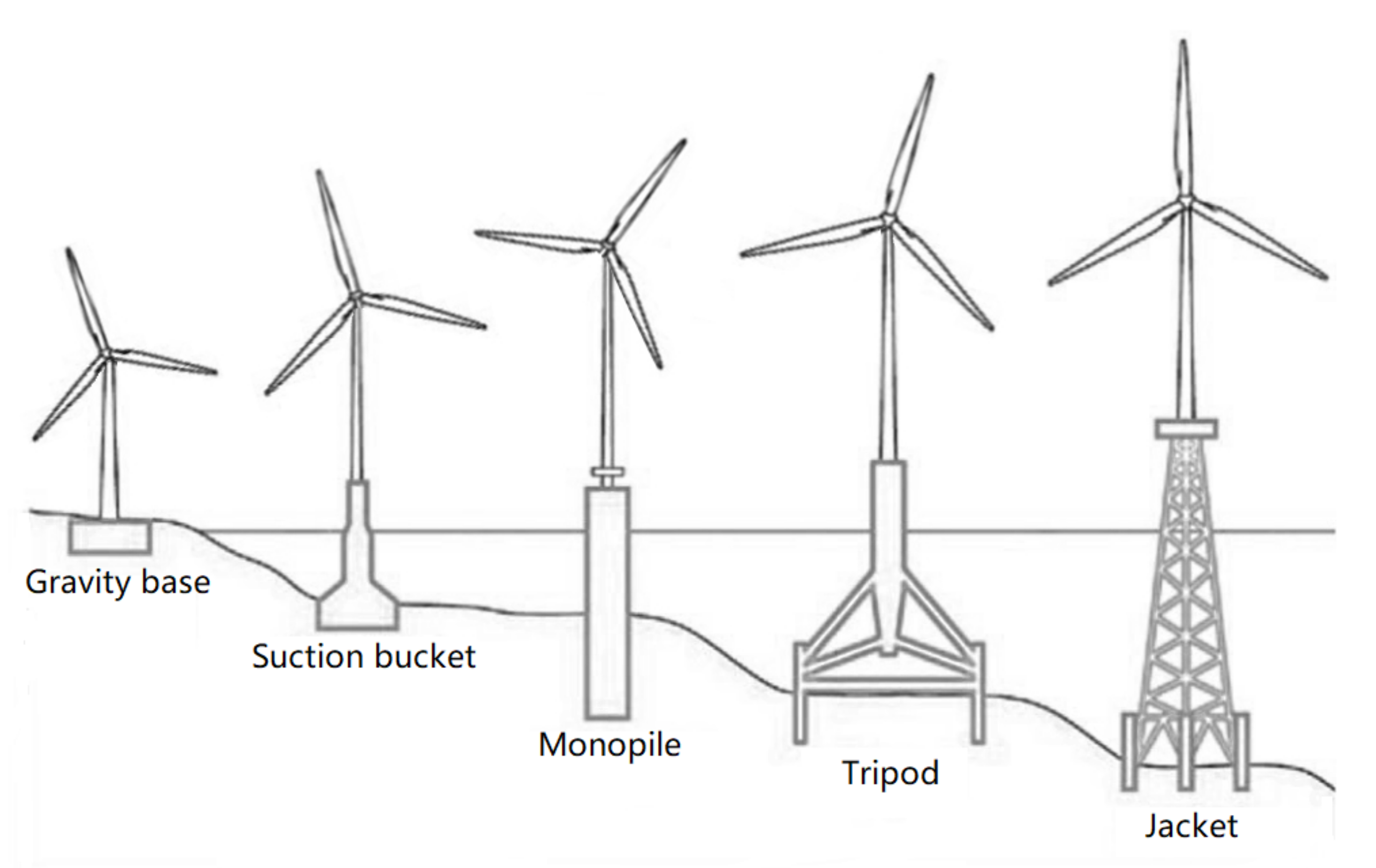
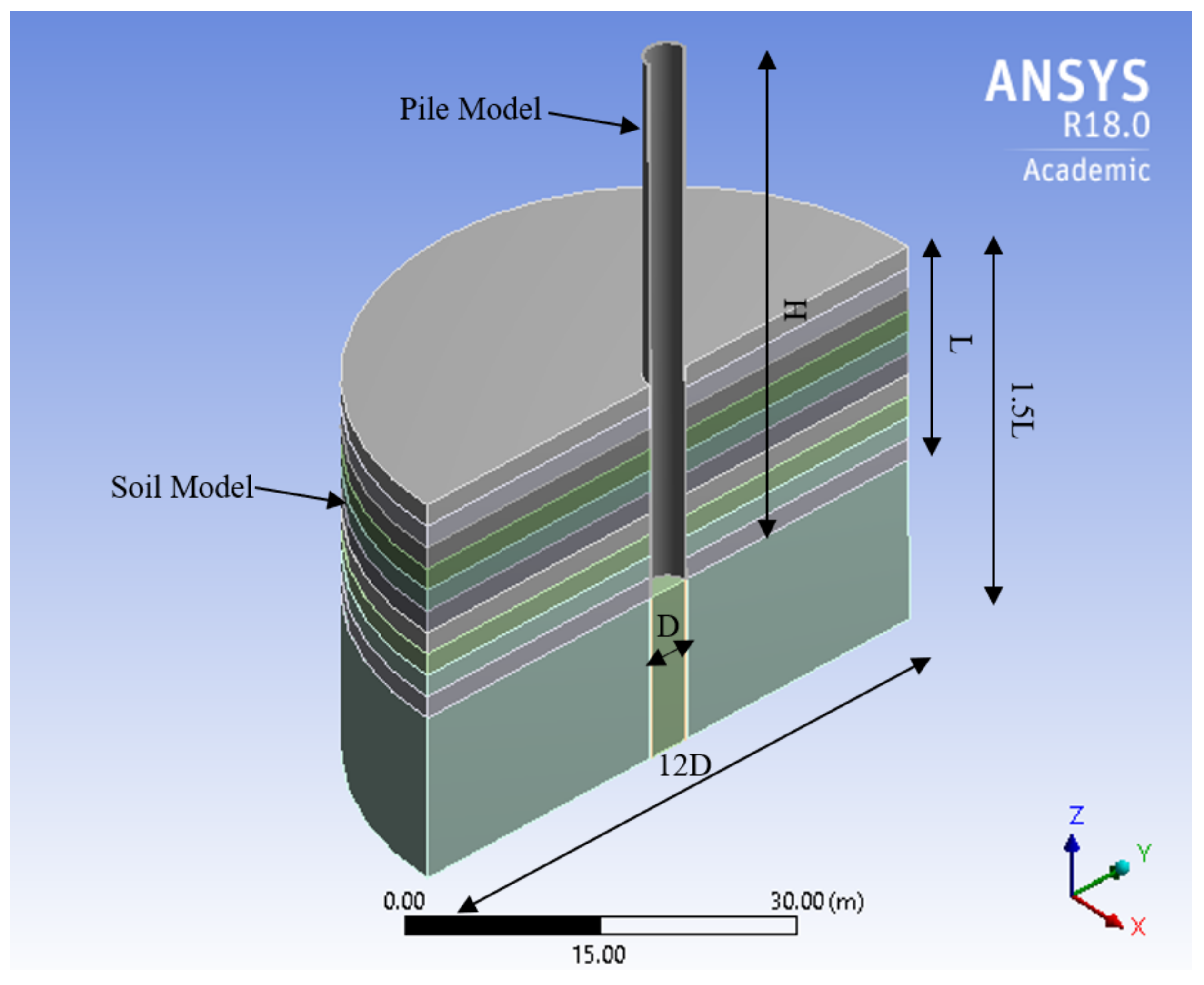
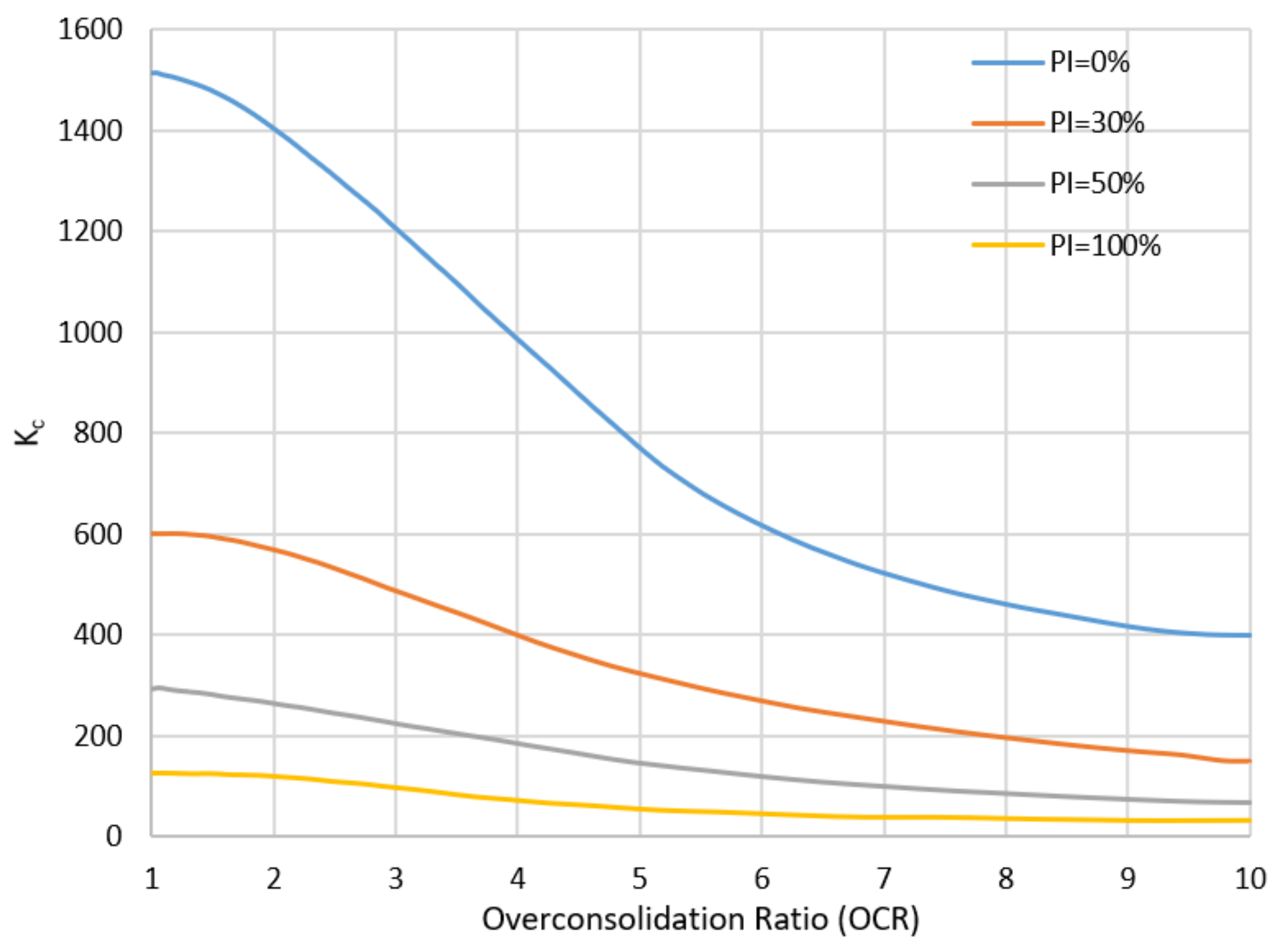
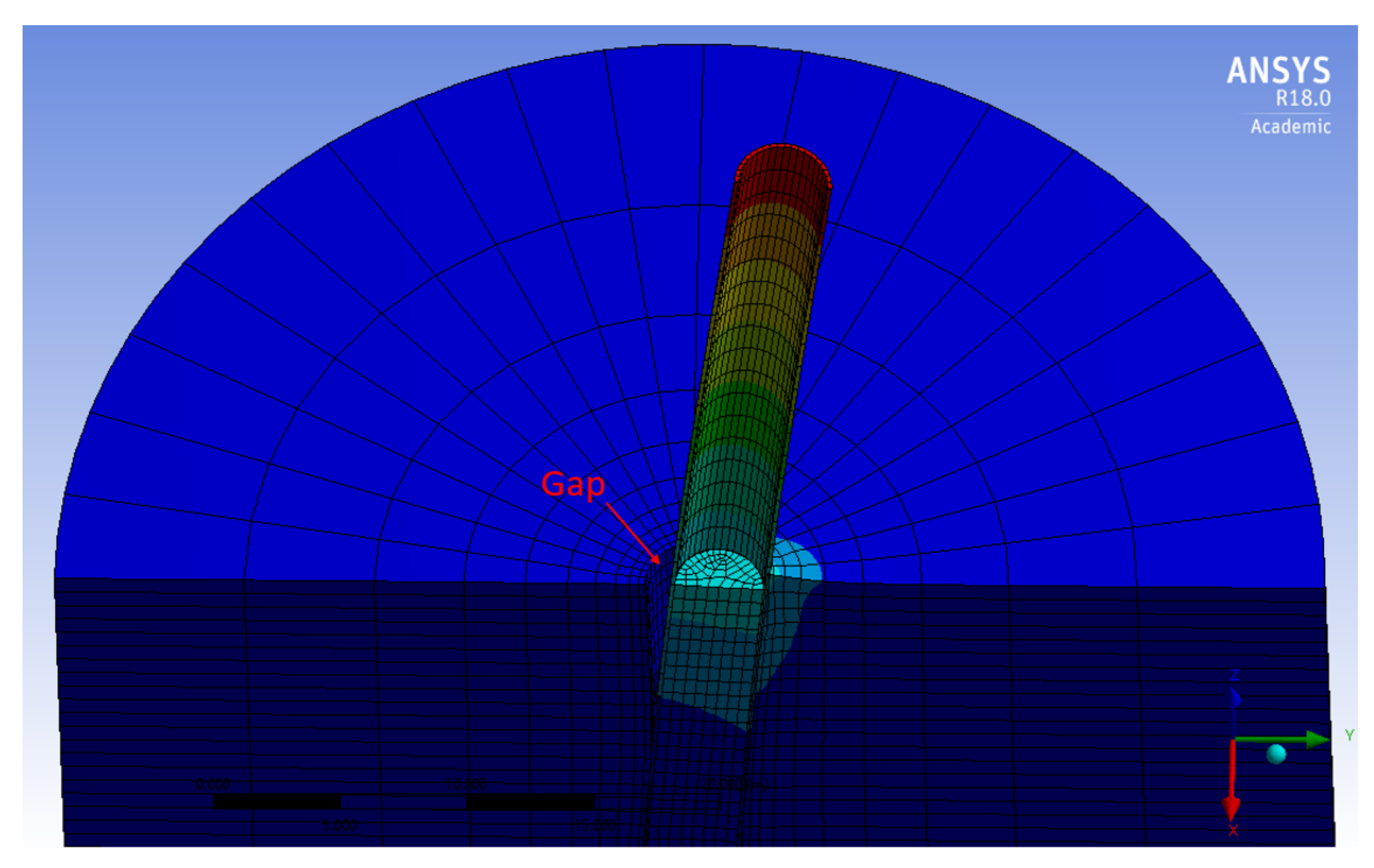
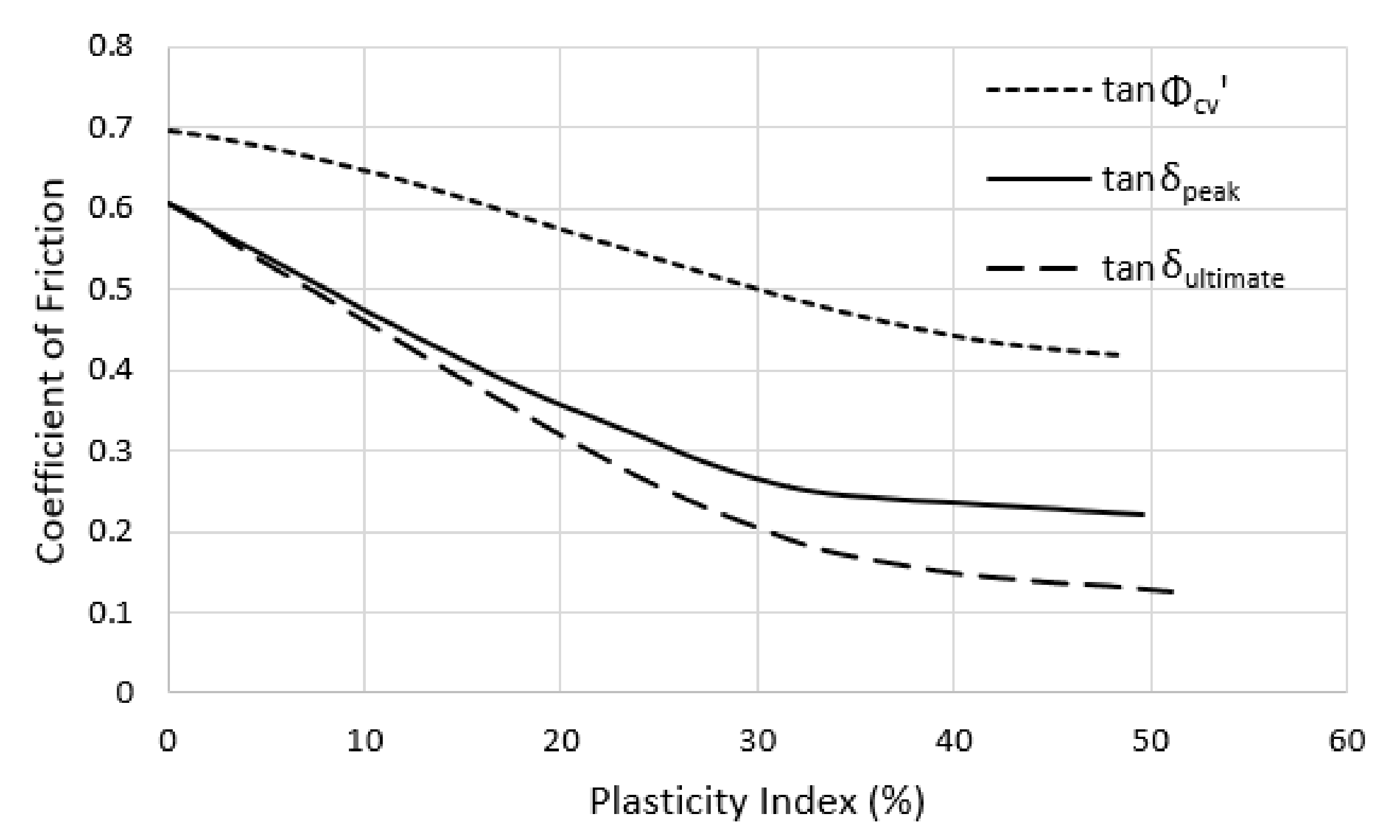
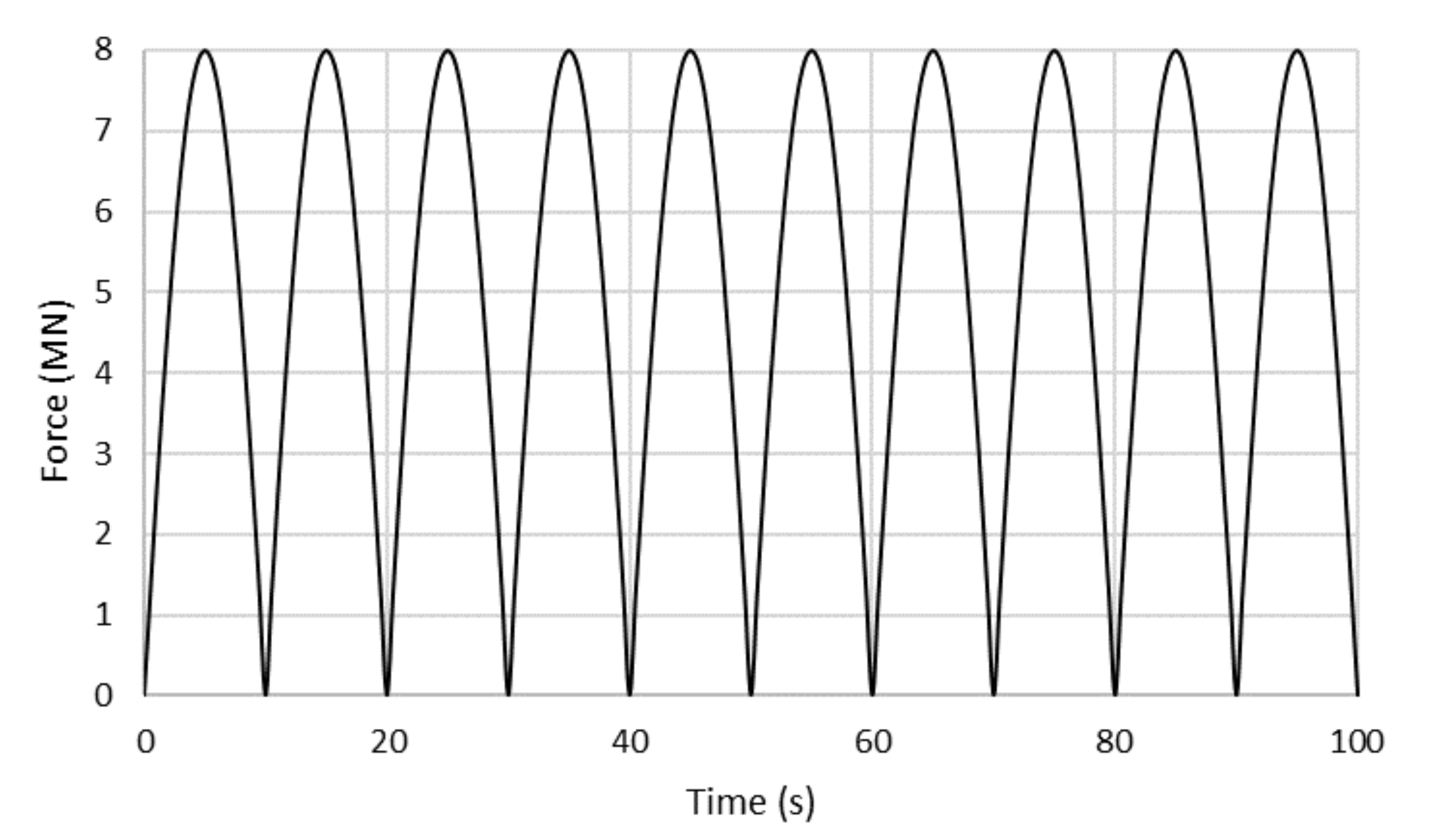
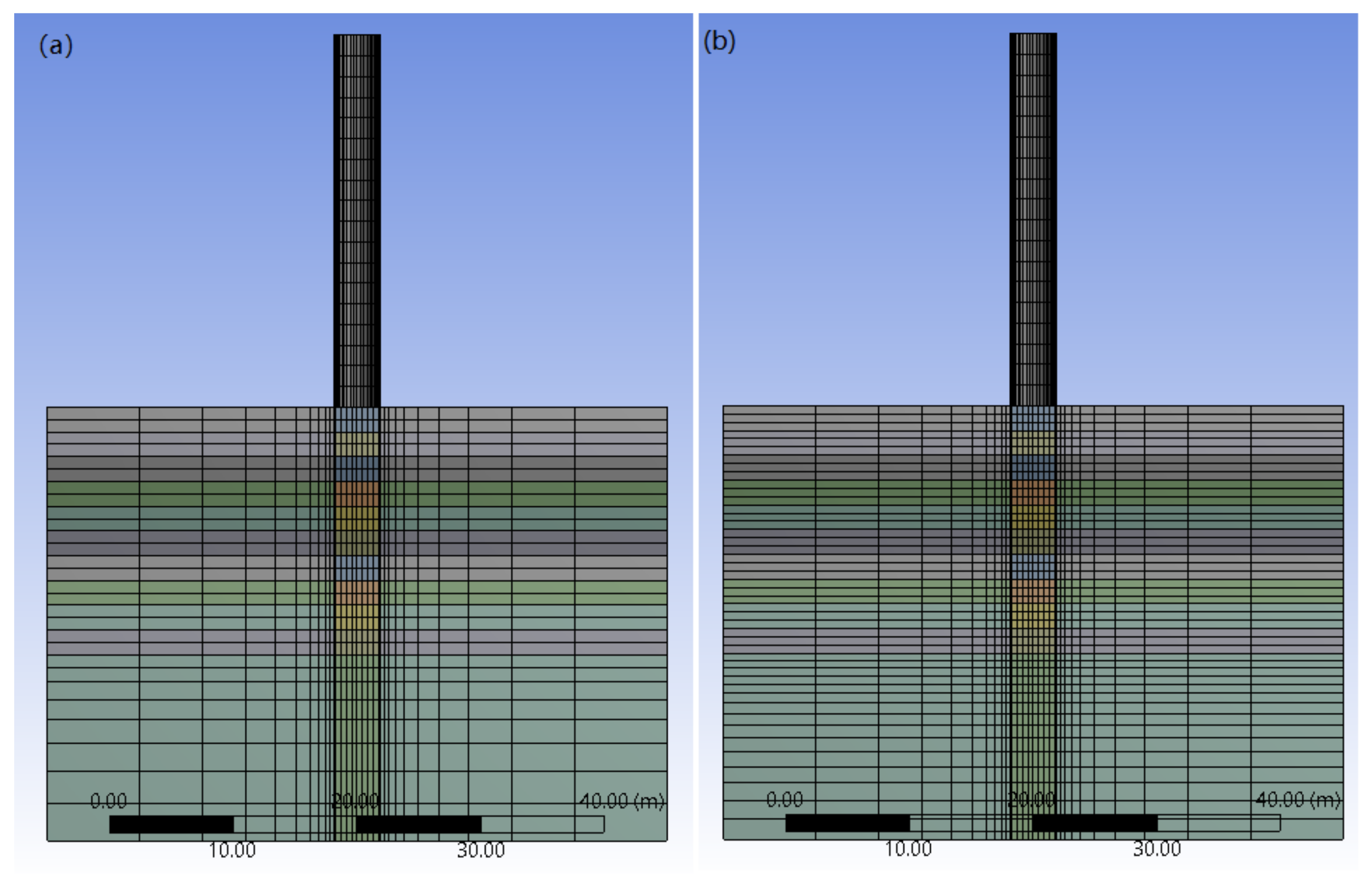
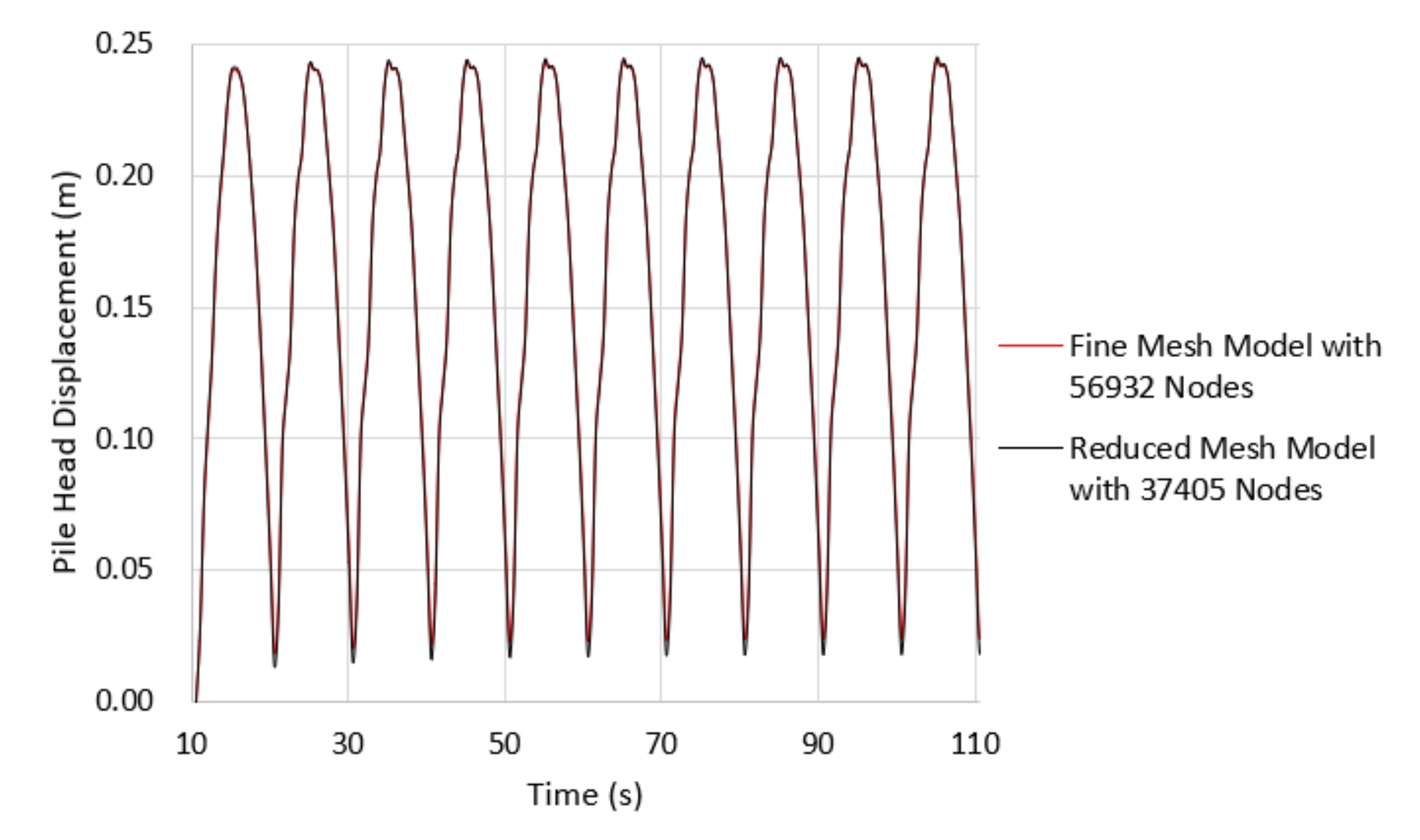
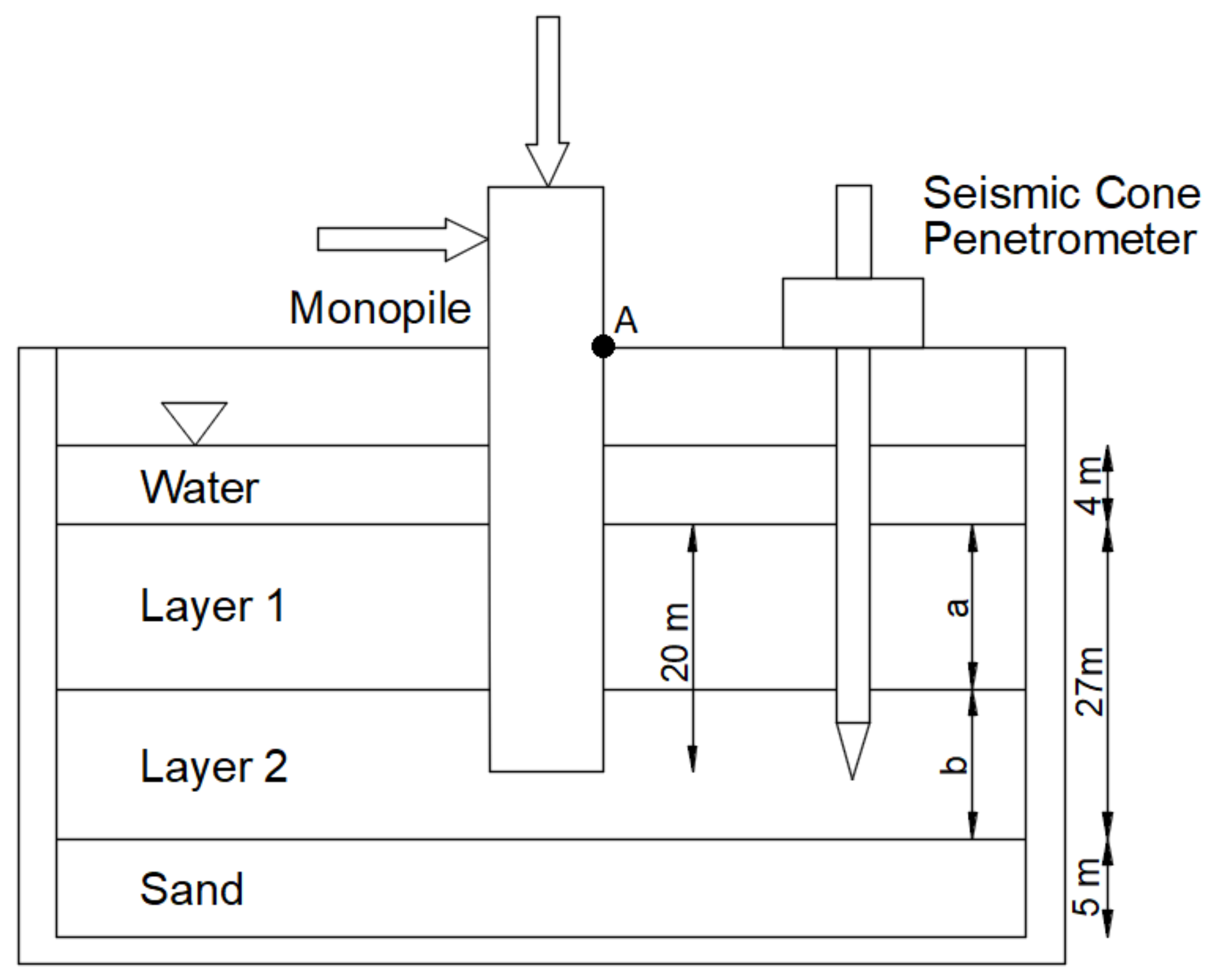

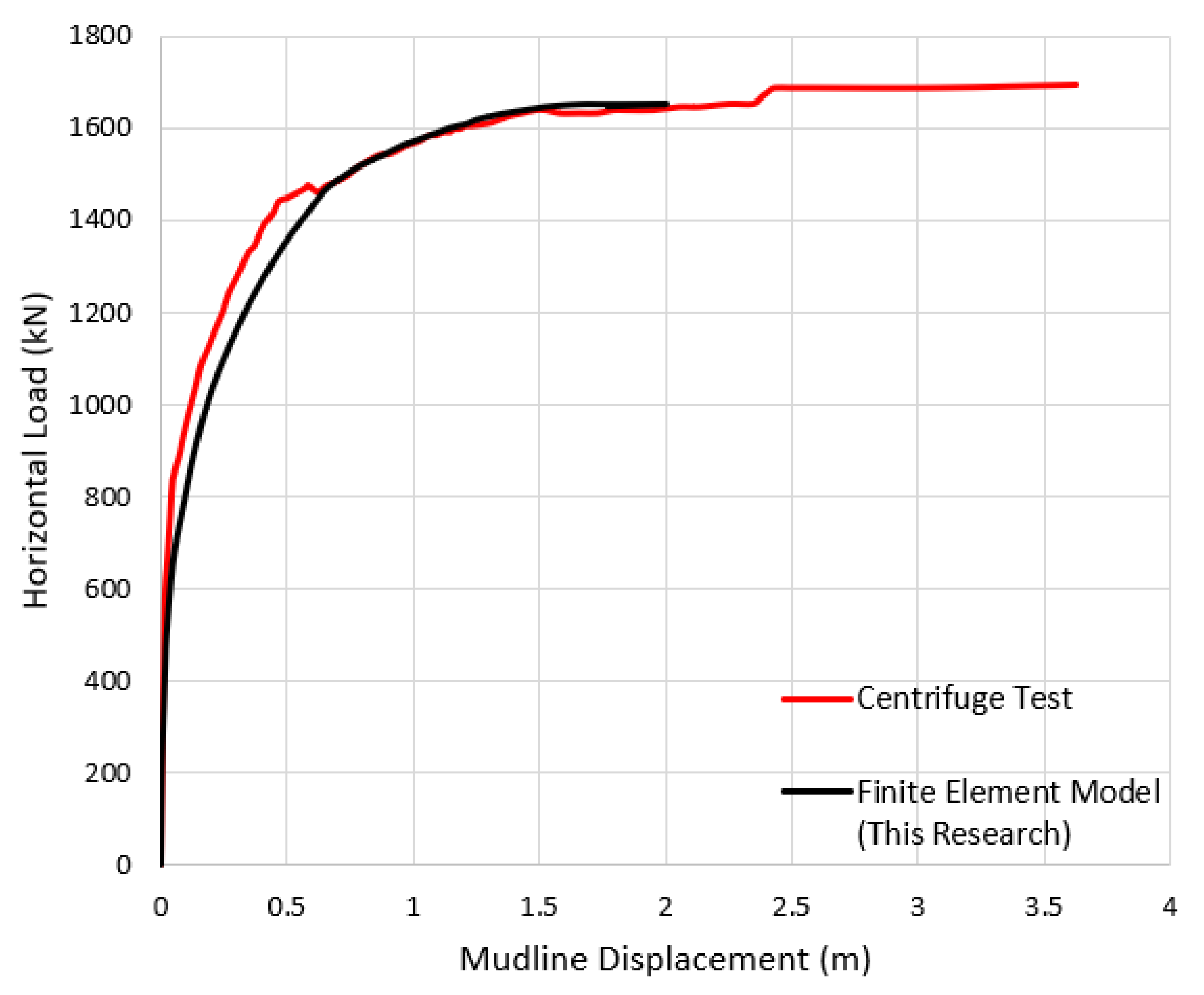


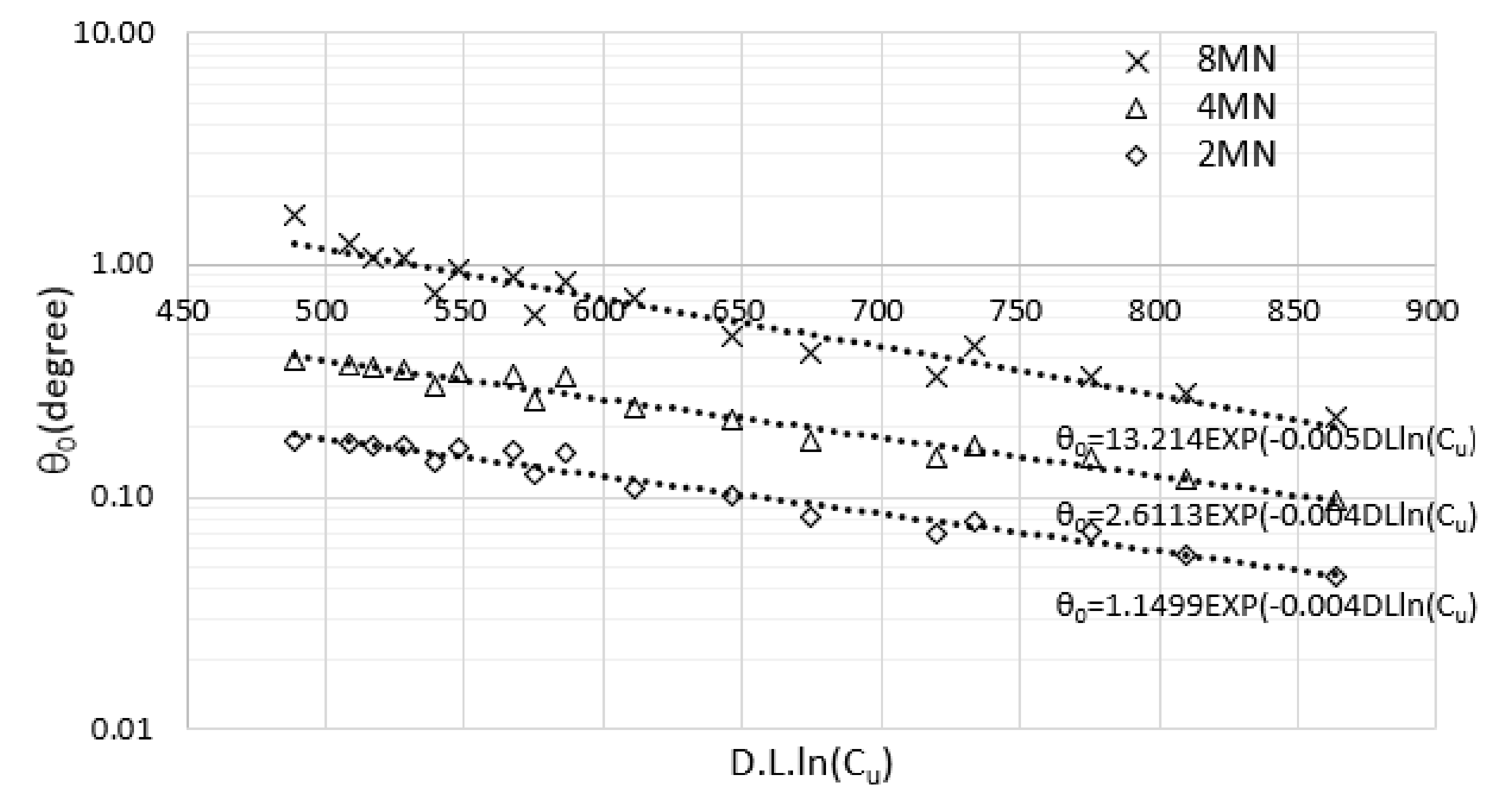

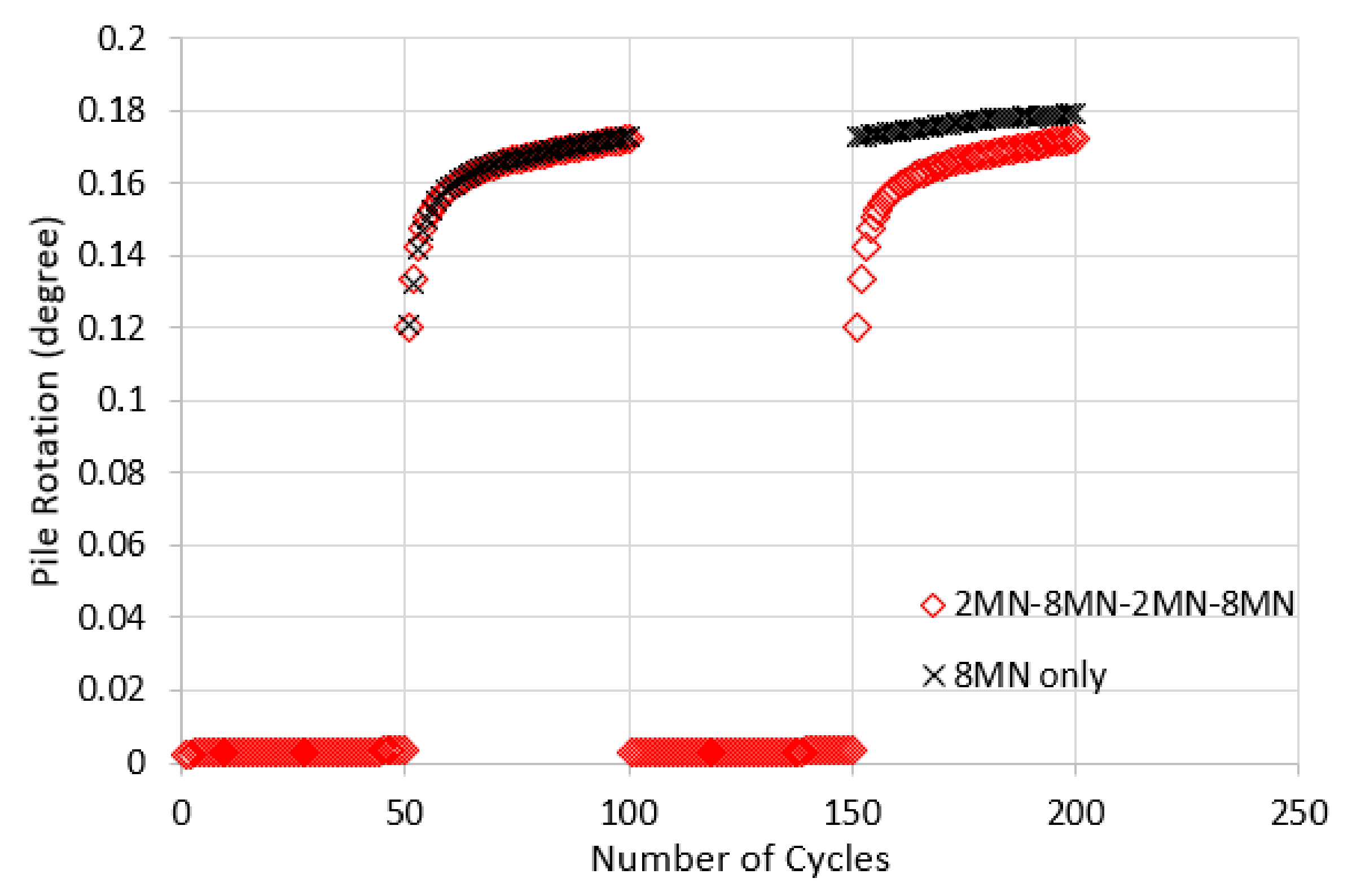
| D—Pile Diameter (m) | tp—Pile Thickness (mm) | H—Total Pile-Structure Length (m) | L—Embedded Length (m) |
|---|---|---|---|
| 5.00 | 57 | 55 | 25–30 |
| 6.25 | 69 | 55 | 25 |
| 7.50 | 82 | 55 | 25 |
| Material | Density (kg/m3) | Young’s Modulus (kPa) | Poisson’s Ratio |
|---|---|---|---|
| Steel | 7850 | 200,000 | 0.3 |
| Clay Type | Unit Weight (kN/m3) | Plasticity Index (%) | Undrained Shear Strength (kPa) | Correction Factor, Kc | Young’s Modulus (kPa) |
|---|---|---|---|---|---|
| 1 | 44 | 50 | 383 | 19,150 | |
| 2 | 40 | 75 | 447 | 33,525 | |
| 3 | 18 | 38 | 100 | 479 | 47,900 |
| 4 (0–10 m depth) | 44 | 50 | 383 | 19,150 | |
| 4 (10–20 m depth) | 40 | 75 | 447 | 33,525 |
| Clay Type | Plasticity Index (%) | Coefficient of Friction |
|---|---|---|
| 1 | 44 | 0.240 |
| 2 | 40 | 0.247 |
| 3 | 38 | 0.250 |
| 4 (0–10 m depth) | 44 | 0.240 |
| 4 (⩾10 m depth) | 40 | 0.250 |
| Site | Layer 1 | Layer 2 | ||
|---|---|---|---|---|
| Depth a (m) | Consolidation Pressure (kPa) | Depth b (m) | Consolidation Pressure (kPa) | |
| A | 13.5 | 500 | 13.5 | 500 |
| B | 13.5 | 300 | 13.5 | 300 |
| C | 13.5 | 180 | 13.5 | 180 |
| D | 5.0 | 180 | 22.0 | 500 |
| E | 10.0 | 180 | 17.0 | 500 |
| Phase | Test Number | Test Nature | Pile Diameter (m) | Vertical Load (MN) | Site Specification |
|---|---|---|---|---|---|
| OWF-01 | 6.5 | B | |||
| I | OWF-02 | Monotonic | 3.83 | 6.5 | A |
| OWF-03 | 4.0 | C | |||
| OWF-04 | 4.0 | C | |||
| OWF-05 | 6.5 | B | |||
| II | OWF-06 | Cyclic | 7.62 | 6.1 | A |
| OWF-07 | 6.0 | D | |||
| OWF-08 | 6.1 | E | |||
| III | OWF-09 | Cyclic | 7.62 | 12.0 | A |
| Stage | OWF-06 | OWF-07 | OWF-08 | OWF-09 | ||||
|---|---|---|---|---|---|---|---|---|
| Min, Max Load (N) | No. of Cycles | Min, Max Load (N) | No. of Cycles | Min, Max Load (N) | No. of Cycles | Min, Max Load (N) | No. of Cycles | |
| 1 | 0, 3 | 1000 | 0, 3 | 1000 | 0, 3 | 1000 | 0, 6 | 1000 |
| 2 | −3.2, 36 | 1000 | 2, 32.5 | 1000 | 0.2, 31.2 | 1000 | −1, 60 | 1000 |
| 3 | −2.5, 79 | 1000 | −19.5, 56.5 | 500 | 3.6, 79 | 1000 | 5, 150 | 1000 |
| 4 | 0, 100 | 100 | −0.6, 100 | 500 | 10.6, 111 | 500 | 17.3, 223 | 1000 |
| 5 | NA | NA | −30, 123 | 479 | −30.6, 121 | 500 | −65, 238 | 500 |
| 6 | NA | NA | 14, 167.5 | 500 | −12.5, 140 | 500 | −86, 217 | 500 |
| 7 | Monotonic Push | |||||||
| Layer | Monotonic Behaviour Validation | Cyclic Behaviour Validation | |||||||
|---|---|---|---|---|---|---|---|---|---|
| Depth (m) | OCR | Kc | Cu (kPa) | E (kPa) | OCR | Kc | Cu (kPa) | E (kPa) | |
| 1 | 1 | 14.7 | 147.0 | 7.7 | 1126.4 | 14.7 | 147.0 | 24.0 | 3520.8 |
| 2 | 3 | 9.8 | 152.6 | 12.3 | 1879.2 | 9.8 | 152.6 | 27.1 | 4137.3 |
| 3 | 5 | 5.8 | 278.3 | 14.4 | 3998.4 | 5.8 | 278.3 | 35.9 | 9999.7 |
| 4 | 7 | 4.0 | 397.0 | 15.9 | 6301.1 | 10.4 | 147.0 | 44.6 | 6547.5 |
| 5 | 9 | 3.1 | 483.0 | 17.2 | 8326.7 | 8.0 | 197.7 | 46.9 | 9264.0 |
| 6 | 11 | 2.5 | 527.7 | 18.1 | 9530.9 | 6.5 | 251.0 | 50.2 | 12,607.2 |
| 7 | 13 | 2.1 | 561.7 | 18.6 | 10,453.4 | 5.5 | 293.0 | 54.4 | 15,948.2 |
| 8 | 15 | 1.8 | 579.6 | 19.2 | 11,103.3 | 4.7 | 341.0 | 56.3 | 19,205.9 |
| 9 | 17 | 1.6 | 589.2 | 19.7 | 11,608.8 | 4.0 | 394.0 | 60.9 | 24,012.6 |
| 10 | 19 | 1.3 | 597.3 | 21.2 | 12,668.1 | 3.5 | 441.0 | 65.4 | 28,823.3 |
| 11 | 20 | 1.3 | 599.5 | 22.0 | 13,206.5 | 3.3 | 454.0 | 67.9 | 30,817.9 |
| Model No. | Pile Diameter, D (m) | Embedded Pile Length, L (m) | Undrained Shear Strength, Cu (kPa) | Number of Cycles, N |
|---|---|---|---|---|
| 1 | 5.00 | |||
| 2 | 6.25 | 25 | 50 | 100 |
| 3 | 7.50 | |||
| 4 | 5.00 | |||
| 5 | 6.25 | 25 | 75 | 100 |
| 6 | 7.50 | |||
| 7 | 5.00 | |||
| 8 | 6.25 | 25 | 100 | 100 |
| 9 | 7.50 | |||
| 10 | 5.00 | |||
| 11 | 6.25 | 25 | 50 & 75 | 100 |
| 12 | 7.50 | |||
| 13 | 26 | |||
| 14 | 27 | |||
| 15 | 5.00 | 28 | 50 | 100 |
| 16 | 29 | |||
| 17 | 30 |
| Model No. | Pile Diameter, D (m) | Embedded Pile Length, L (m) | Undrained Shear Strength, Cu (kPa) | D × L × ln(Cu) (m2 ln(kPa)) | Rotation 0 (Degree) |
|---|---|---|---|---|---|
| 1 | 5.00 | 489 | 1.65 | ||
| 2 | 6.25 | 25 | 50 | 611 | 0.72 |
| 3 | 7.50 | 734 | 0.45 | ||
| 4 | 5.00 | 540 | 0.76 | ||
| 5 | 6.25 | 25 | 75 | 675 | 0.42 |
| 6 | 7.50 | 810 | 0.28 | ||
| 7 | 5.00 | 576 | 0.61 | ||
| 8 | 6.25 | 25 | 100 | 720 | 0.33 |
| 9 | 7.50 | 863 | 0.22 | ||
| 10 | 5.00 | 517 | 1.07 | ||
| 11 | 6.25 | 25 | 62.5 | 646 | 0.49 |
| 12 | 7.50 | 775 | 0.33 | ||
| 13 | 26 | 509 | 1.24 | ||
| 14 | 27 | 528 | 1.08 | ||
| 15 | 5.00 | 28 | 50 | 548 | 0.96 |
| 16 | 29 | 567 | 0.89 | ||
| 17 | 30 | 587 | 0.85 |
Publisher’s Note: MDPI stays neutral with regard to jurisdictional claims in published maps and institutional affiliations. |
© 2021 by the authors. Licensee MDPI, Basel, Switzerland. This article is an open access article distributed under the terms and conditions of the Creative Commons Attribution (CC BY) license (https://creativecommons.org/licenses/by/4.0/).
Share and Cite
Xie, M.; Lopez-Querol, S. Numerical Simulations of the Monotonic and Cyclic Behaviour of Offshore Wind Turbine Monopile Foundations in Clayey Soils. J. Mar. Sci. Eng. 2021, 9, 1036. https://doi.org/10.3390/jmse9091036
Xie M, Lopez-Querol S. Numerical Simulations of the Monotonic and Cyclic Behaviour of Offshore Wind Turbine Monopile Foundations in Clayey Soils. Journal of Marine Science and Engineering. 2021; 9(9):1036. https://doi.org/10.3390/jmse9091036
Chicago/Turabian StyleXie, Mian, and Susana Lopez-Querol. 2021. "Numerical Simulations of the Monotonic and Cyclic Behaviour of Offshore Wind Turbine Monopile Foundations in Clayey Soils" Journal of Marine Science and Engineering 9, no. 9: 1036. https://doi.org/10.3390/jmse9091036






